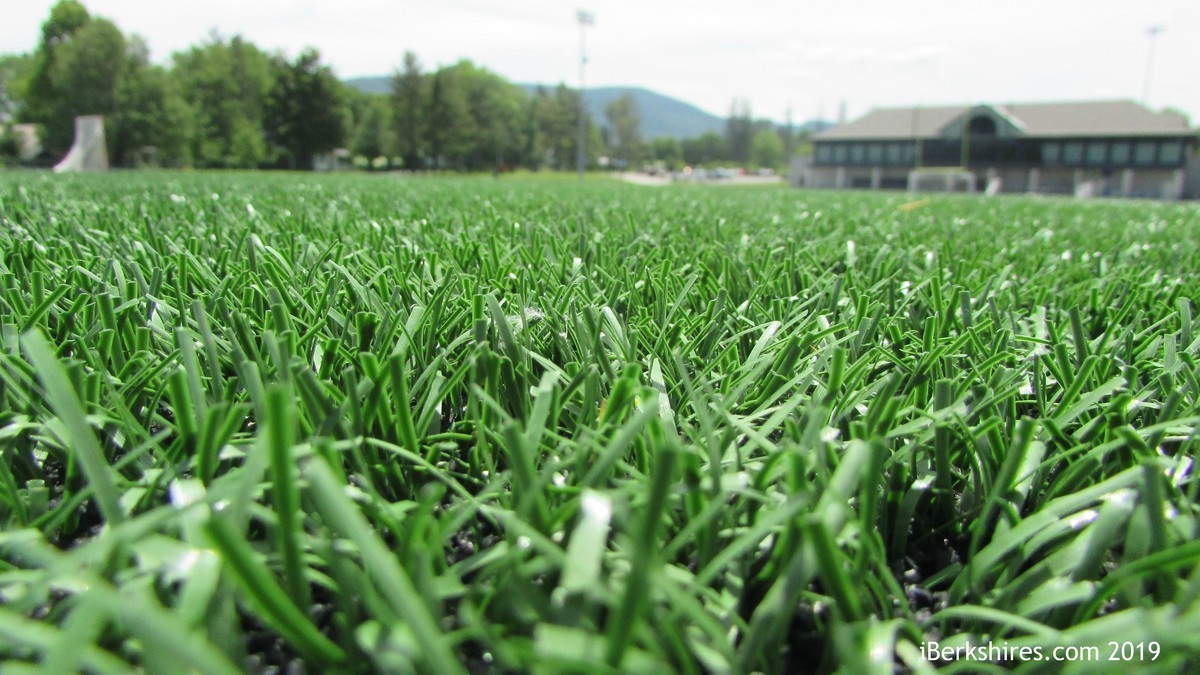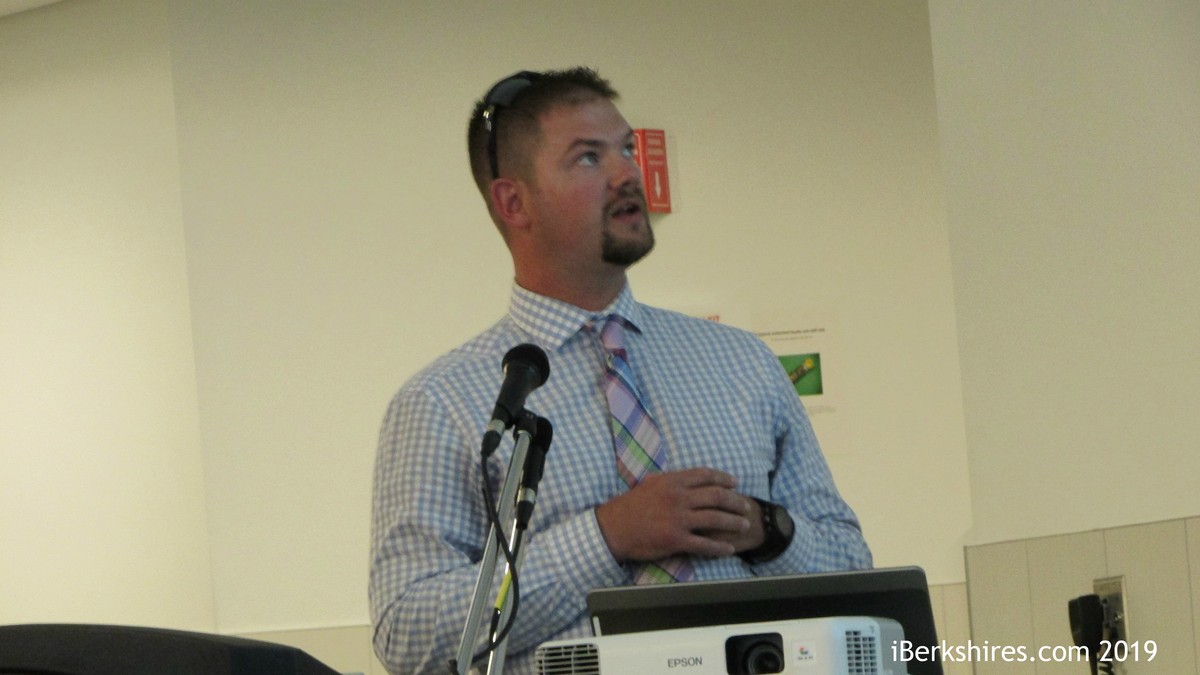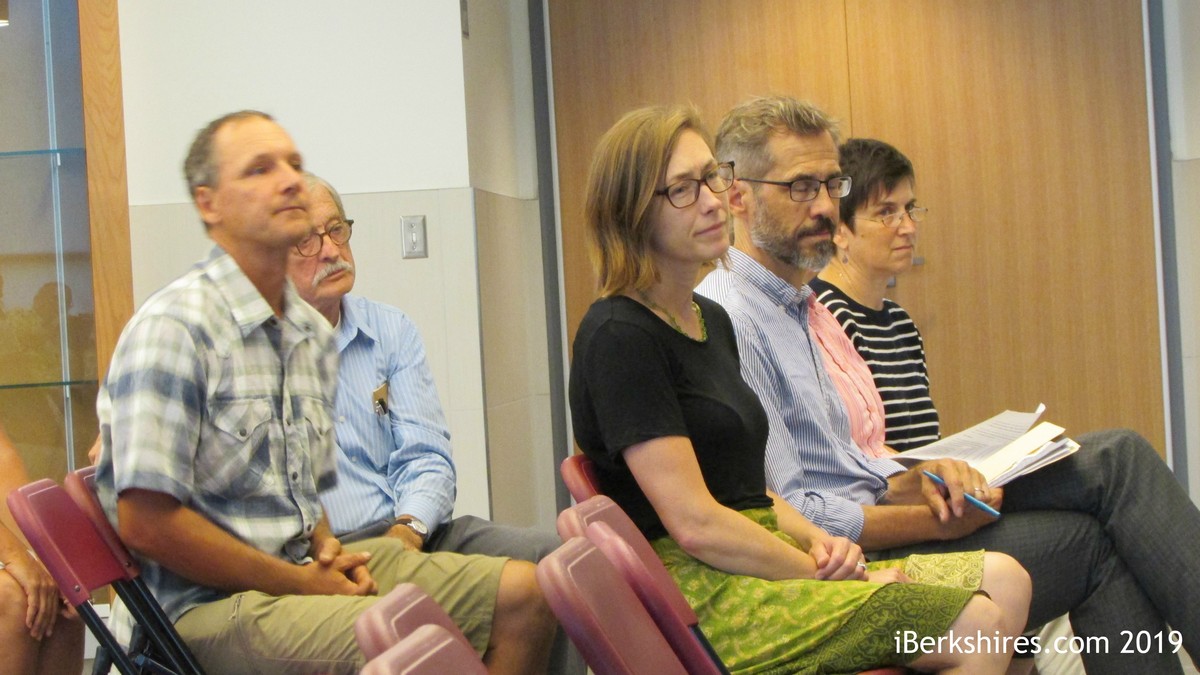Scientific Evidence Unclear on Risk of Artificial Turf FieldsBy Stephen Dravis, iBerkshires Staff
03:58AM / Thursday, August 01, 2019 | |
 The turf field at Williams' Weston Field, one of only three in the county. Mount Greylock's decision to go with artificial turf has raised concerns over health and environmental issues. The turf field at Williams' Weston Field, one of only three in the county. Mount Greylock's decision to go with artificial turf has raised concerns over health and environmental issues. |

Justin Robertshaw of Traverse Landscape Architects tells the School Committee the reasons why its subcommittee decided to recommend an artificial turf field.
WILLIAMSTOWN, Mass. — From excessive heat to scrapes to cancer, the latest generation of artificial turf has been accused of being a safety risk that is unacceptable for use on athletic fields like the one being contemplated at Mount Greylock Regional School.
Even proponents of the turf will concede the first two points, admitting that "turf burn" abrasions are a real and that synthetic surfaces do get hotter than natural grass.
But reports of higher cancer incidences among athletes with long-term exposure to synthetic surfaces are highly anecdotal and do not stand up to scientific scrutiny, proponents say. And the health benefits of a reliable playing surface for interscholastic sports and physical education programs outweigh the other risks, according to those urging the district to invest in an artificial turf field at the middle-high school.
There are other arguments for and against an artificial surface, including the relative costs of maintaining natural and synthetic fields. And many arguments on both sides were raised in a 2 1/2-hour forum hosted by the Mount Greylock School Committee on Tuesday night.
Perhaps the most serious concern for many and the one that catches the ear of many parents in the district is the idea that artificial surfaces can expose youngsters to dangers not found on grass fields.
That debate begins in Washington State and ends — proponents hope — in Washington, D.C.
In 2009, the women's soccer coach at the University of Washington began reporting what she considered a high rate of athletes diagnosed with cancer after playing on artificial turf fields.
That led the Washington State Department of Health to conduct a study, and its January 2017 report is one of several cited by proponents of the artificial turf fields as evidence of its safety.
"We found that the number of cancers among all soccer players reported by [UW soccer coach Amy Griffin] was less than expected given rates of cancer in Washington residents," the report read in part.
Justin Robertshaw of Traverse Landscape Architects mentioned that report among others Tuesday in his presentation to the School Committee. Traverse, based in Rhode Island, is advising the Mount Greylock subcommittee charged with developing a plan to address the deficient athletic fields at the middle-high school.
"Crumb rubber has been studied for over a decade," Robertshaw said, referring to the artificial field's infill material made from recycled automotive tires. "[Subcommittee chair John Skavlem] mentioned numerous state boards of health, including Washington, New Jersey, New York and California. All looked at crumb rubber infill and the potential hazard to human health.
"The EPA decided to take up this study in 2015. The study has been slightly delayed. As of last Thursday, the first part of the study was released to the public. What they found was … crumb rubber is made from metals and organic chemicals, and they did find those materials in the infill. They wanted to further evaluate the risk to human health, and they tested emissions into the air of those particles and transmission by biological fluids .. on the assumption you come into contact by bodily fluids or ingest it.
"What they found is that while there are emissions … it presents a low risk to human health. They are not concluding there's absolutely no risk, but as their standards currently sit, they're concluding it is of low risk to human health."
Actually, EPA report released last week is a little more nuanced.
In its executive summary, the federal agency says that its goal is to "fill specific data gaps about the potential for human exposure to chemical constituents associated with recycled tire crumb rubber used in synthetic turf fields."
But the second paragraph of the foreward of the 334-page report says: "The study is not a risk assessment; however the results of research described in this and future [EPA] reports will advance our understanding of exposure to inform the risk assessment process."
And that Washington Department of Health Study?
Four months after its initial report, the Washington DOH released a revised report that includes language that makes its research sound like less than a full exoneration of the artificial surface.
"The purpose of our investigation was to explore whether the information from Coach Griffin's list warranted further public response," the revised report reads, adding the next sentence in bold print: "Our investigation was not designed to determine if soccer players in general were at increased risk of cancer due to exposures from crumb rubber in artificial turf."
In other words, a definitive scientific study of cancer does not exist — at least in this country.
In 2016, the National Institute for Public Health and the Environment in the Netherlands concluded that health risks from artificial turf are, "virtually negligible."
Opponents of the artificial turf plan at Mount Greylock brought issues to Tuesday's discussion that they believe poke holes in the most favorable existing research.
"There have been a lot of studies done, and those studies have tended to arrive at the conclusion that there isn't proof of higher risk," Peter Low told the School Committee. "That doesn't mean it's been proven there is no health risk. And we can't know that for years to come.
"It reminds me of the decades-long debate over tobacco. For the longest time, the tobacco industry in its studies claimed there was no proof tobacco caused cancer. By the time science caught up, it was too late. I'm not suggesting this is exactly equivalent, but I do believe there's a real risk. If children are the main users, why take that risk?"
Low also argued that the higher temperatures associated with artificial turf — in addition to raising the risk of dehydration — also mean that the crumb rubber gives off more gas on hot days. However, the EPA study released last week did report air emissions tests conducted at both 77 degrees and 140 degrees without triggering any alarms.
And those abrasions that even artificial turf proponents admit are a fact of life with the playing surface cause concern for the opponents because, they say, skin irritation makes it more likely that users will absorb potential carcinogens directly into their bodies.
Cancer was not the only serious health risk discussed at Tuesday's forum.
Much was made of the potential for heat stroke and dehydration from practicing and playing on an artificial turf field.
Opponents said that while for the bulk of the school year, temperatures may be reasonable, fall sports begin practice in mid-August and hot days are not uncommon through September — even without taking into account the potential for climate change over the next few decades. And one commenter noted that the pro-synthetic turf side argued the artificial turf could bring in "revenue" to the district, which opens the possibility of hosting summer camps on the proposed field.
Mount Greylock Athletic Director Lindsey von Holtz attempted to allay some of the concern over heat exposure by saying that the Massachusetts Interscholastic Athletic Association is imposing new rules this fall to address high heat on all outdoor playing surfaces. Coaches will be required to measure the surface temperature before a practice or game and implement a protocol that includes mandatory rest and water breaks at specified temperatures.
One of the residents who arranged in advance to address the School Committee at Tuesday's forum was Nicholas Wright, a retired medical school professor and epidemiologist who currently teaches winter study courses at Williams College on how to critically assess scientific studies.

A number of residents came to Tuesday's School Committee forum about whether to install an artificial turf field at the middle-high school.
Wright indicated he was disappointed by most of the scholarship he found about artificial turf fields but did point to a pair of peer-reviewed studies published in the American Journal of Sports Medicine and The Knee that found a significant increase in knee injuries among football players playing on artificial turf fields versus their peers on natural grass.
He was countered by Williamstown physical therapist David Armet and Dr. Suk Namkoong, an orthopedic surgeon and the director of medical athletics at Williams College.
Armet said the studies cited by Wright were drawn from NCAA data about elite college football players and, therefore, not relevant to a discussion about artificial turf fields for middle and high school soccer players, lacrosse players and phys ed students.
Namkoong said that his profession has expressed no opinion to the effect that artificial surfaces are more dangerous than grass fields.
"Most would suggest a turf field is better than a poorly maintained natural grass surface," Namkoong said.
In fact, he echoed the opinion expressed by other proponents at Tuesday's forum: A more reliably available turf field that allows games to be played as scheduled is beneficial compared to grass fields that require frequent rescheduling of games.
"I've been in practice here since 2004," Namkoong said. "I've seen a lot of injuries. The bigger problem is overuse — when fields are not available and games are compressed into a shorter calendar.
"Two of my kids play all year round, different sports. I have no concerns about them playing on artificial turf fields."
The School Committee took no action at Tuesday's forum, which was called solely to gather input from the community. The committee's only action on the question to date was a decision to put the project out to bid. It was reported on Tuesday the bid documents are not yet ready; if and when the district has bids in hand, the committee will have to decide whether to accept one of the bids and move forward with the fields — including the synthetic field — as designed by Traverse.
| 
